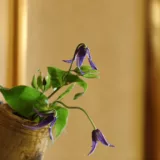Introduction to Yuzen Dyeing
Yuzen dyeing12, a venerable traditional Japanese technique, is renowned for its exquisite application in coloring kimonos and obi (kimono sashes). Like painting on a canvas, it employs a palette of varied hues to produce stunning, picturesque designs on fabric.
The credit for establishing Yuzen dyeing goes to Miyazaki Yuzensai, a celebrated fan painter active in Kyoto from the Jōtei era (1684-1688) to the Genroku era (1688-1704) of the Edo period. Incorporating the popular designs of Yuzensai’s fans into kimono patterns marked the inception of Yuzen dyeing. The technique is said to have derived its name, “Yuzen,” from its originator, Yuzensai.

Unique Characteristics of Yuzen Dyeing
The distinctive feature of Yuzen dyeing is using a special resist paste to prevent the colors from bleeding into each other. The process involves tracing the design’s outlines with thin lines of this paste, known as itome-nori. Thanks to this protective layer, the dye does not seep out, creating vibrant, picturesque patterns akin to a painting. Most of the motifs revolve around themes of nature, such as flowers, birds, wind, moon, and seasonal flora.

Japan’s proud dyeing techniques
In the vast realm of kimono dyeing techniques, there’s more than just Yuzen. Techniques such as shibori3 (tie-dye), katazome4 (stencil dyeing), and roketsuzome5 (wax-resist dyeing) offer a diverse array of options. However, hand-drawn Yuzen stands out as a method where each step, demanding delicate precision, is carried out by hand, resulting in a piece of art in which Japan takes great pride.
The first step involves sketching an underdrawing on the fabric using “ao-hana,” a blue liquid extracted from the dayflower plant. Over this underdrawing, thin lines of resist paste are placed, squeezed out from a paper tube coated with persimmon tannin and fitted with a brass tip. After washing, these resist lines remain vividly white, accentuating the beauty of hand-drawn Yuzen, strikingly contrasting the vibrant colors and the white lines.

The Evolution and Recognition of Yuzen Dyeing
Originating in Kyoto, the technique of Yuzen dyeing has spread across Japan, evolving uniquely in each region. Although Kyo-Yuzen is particularly notable, the dyeing of the Yuzen in Kyoto is also notable. Backed by a millennium of culture, Kyo-Yuzen boasts bright, refined colors and elegant, exquisite patterns. Today, it stands as a highly popular textile art not only within Japan but also across the globe, a testament to the universal appeal of its beauty.

Click here to see the works of Yuzen dyeing artist Toki Hata




